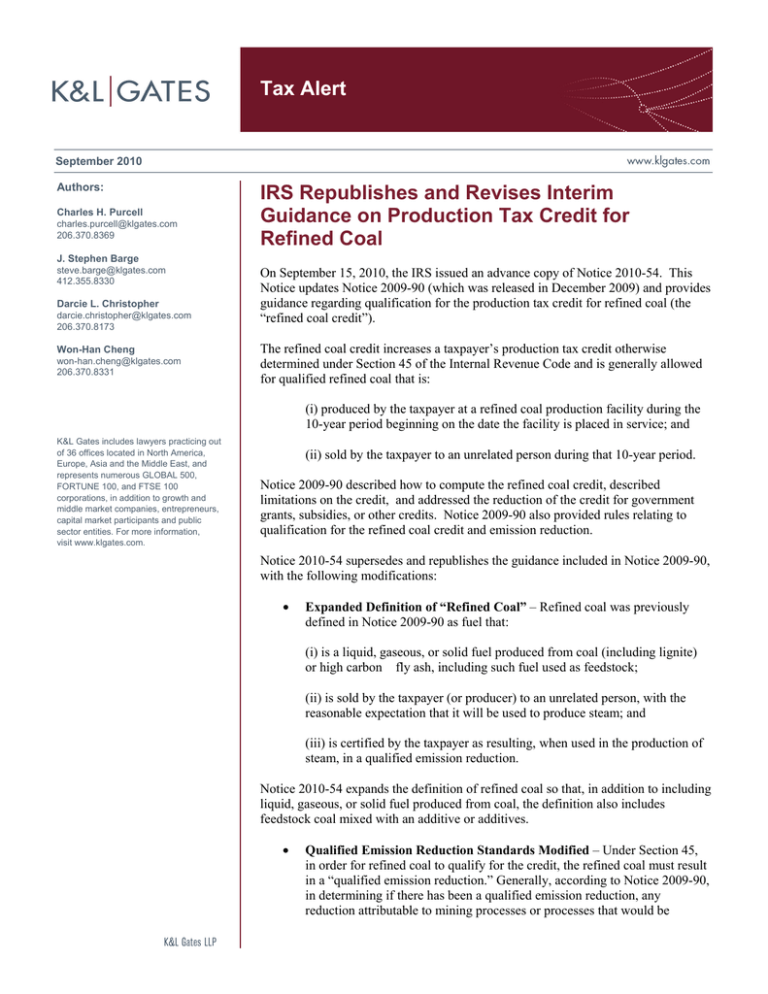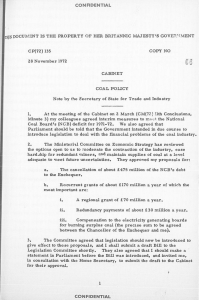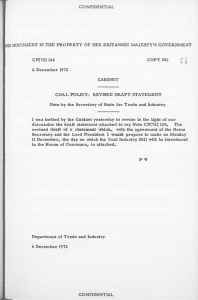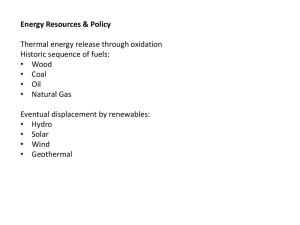
Tax Alert
September 2010
Authors:
Charles H. Purcell
charles.purcell@klgates.com
206.370.8369
IRS Republishes and Revises Interim
Guidance on Production Tax Credit for
Refined Coal
J. Stephen Barge
steve.barge@klgates.com
412.355.8330
Darcie L. Christopher
darcie.christopher@klgates.com
206.370.8173
Won-Han Cheng
won-han.cheng@klgates.com
206.370.8331
On September 15, 2010, the IRS issued an advance copy of Notice 2010-54. This
Notice updates Notice 2009-90 (which was released in December 2009) and provides
guidance regarding qualification for the production tax credit for refined coal (the
“refined coal credit”).
The refined coal credit increases a taxpayer’s production tax credit otherwise
determined under Section 45 of the Internal Revenue Code and is generally allowed
for qualified refined coal that is:
(i) produced by the taxpayer at a refined coal production facility during the
10-year period beginning on the date the facility is placed in service; and
K&L Gates includes lawyers practicing out
of 36 offices located in North America,
Europe, Asia and the Middle East, and
represents numerous GLOBAL 500,
FORTUNE 100, and FTSE 100
corporations, in addition to growth and
middle market companies, entrepreneurs,
capital market participants and public
sector entities. For more information,
visit www.klgates.com.
(ii) sold by the taxpayer to an unrelated person during that 10-year period.
Notice 2009-90 described how to compute the refined coal credit, described
limitations on the credit, and addressed the reduction of the credit for government
grants, subsidies, or other credits. Notice 2009-90 also provided rules relating to
qualification for the refined coal credit and emission reduction.
Notice 2010-54 supersedes and republishes the guidance included in Notice 2009-90,
with the following modifications:
•
Expanded Definition of “Refined Coal” – Refined coal was previously
defined in Notice 2009-90 as fuel that:
(i) is a liquid, gaseous, or solid fuel produced from coal (including lignite)
or high carbon fly ash, including such fuel used as feedstock;
(ii) is sold by the taxpayer (or producer) to an unrelated person, with the
reasonable expectation that it will be used to produce steam; and
(iii) is certified by the taxpayer as resulting, when used in the production of
steam, in a qualified emission reduction.
Notice 2010-54 expands the definition of refined coal so that, in addition to including
liquid, gaseous, or solid fuel produced from coal, the definition also includes
feedstock coal mixed with an additive or additives.
•
Qualified Emission Reduction Standards Modified – Under Section 45,
in order for refined coal to qualify for the credit, the refined coal must result
in a “qualified emission reduction.” Generally, according to Notice 2009-90,
in determining if there has been a qualified emission reduction, any
reduction attributable to mining processes or processes that would be
Tax Alert
treated as mining if performed by the mine
owner or operator is not taken into account.
Notice 2010-54 modifies this rule to allow
consideration of certain processing of utilitygrade coal in determining whether there has
been a qualified emission reduction.
Specifically, the reduction will be taken into
account in determining whether there has been a
qualified emission reduction if:
(i) the process modifies utility-grade coal;
(ii) it consists of predominantly operations
that are not ordinarily performed on similar
coal by a mine owner or operator; and
(iii) the process goes beyond that necessary
for the production of utility-grade coal from
similar coal.
•
Revision of Emissions Testing Protocols –
Notice 2009-90 contained specific testing
protocols for determining whether a
reduction in emissions was sufficient to
meet the requirements of a qualified
emission reduction for purposes of
qualifying for the refined coal credit.
Notice 2010-54 restates the testing
protocols included in Notice 2009-90, with
the following modifications:
o
Under Notice 2009-90, emissions
reduction could be determined using
continuous emission monitoring system
(CEMS) field testing, provided that
such testing met certain requirements.
Notice 2010-54 restates this general
rule, but also provides that downstream
CEMS testing is permitted as long as
specific requirements described in
Notice 2010-54 are met.
o
Notice 2009-90 also allowed for certain
other testing methods, including a
testing method using a demonstration
pilot-scale combustion furnace and
laboratory analysis of feedstock coal
and refined coal. Notice 2010-54
expands the description of the types of
laboratory and analytical methods that
may be used to establish the requisite
emissions reduction for SO2 or Hg.
o
In some cases, a re-determination of
emissions reduction may be required.
Where the re-determination is
necessary due to a change in the
process of producing refined coal from
the feedstock coal, the re-determination
must use a method meeting the general
requirements for emissions reduction
testing. In other cases, under Notice
2009-90, the re-determination of the
SO2 or Hg content of both the
feedstock coal and the refined coal
could be satisfied by laboratory
analysis establishing that the SO2 or Hg
content of both the feedstock coal and
the refined coal did not vary by more
than 10% from the SO2 or Hg content
of the feedstock coal and refined coal
used in the most recent determination
meeting the requirements of the notice.
Notice 2010-54 includes this
alternative, but also adds another
alternative for satisfying the redetermination requirement. Under the
new alternative, the re-determination
requirement may be satisfied by
laboratory analysis that establishes that
the SO2 or Hg content of the amount of
refined coal necessary to produce an
amount of useful energy has been
reduced by at least 20% (40%, in the
case of facilities placed in service after
December 31, 2009) in comparison to
the SO2 or Hg content of the amount of
feedstock coal necessary to produce the
same amount of useful energy,
excluding any dilution caused by
materials combined or added during
the production process.
Notice 2010-54 provides that the IRS will continue
its no rule policy concerning the placed in service
date for a facility.
Notice 2010-54 is effective for refined coal
produced after September 16, 2010. However,
taxpayers may apply the provisions of Notice 2010-
September 2010
2
Tax Alert
54 with respect to refined coal produced on or before
September 16, 2010.
It is expected that Notice 2010-54 will appear in
Internal Revenue Bulletin 2010-40 on October 4,
2010.
* * *
Circular 230 Notice
To ensure compliance with requirements imposed by the IRS, we inform you that any U.S. federal tax advice contained in this
communication (including any attachments) is not intended or written to be used, and cannot be used, for the purpose of (i)
avoiding penalties under the Internal Revenue Code of 1986, as amended or (ii) promoting, marketing or recommending to
another party any transaction or matter addressed within.
Anchorage Austin Beijing Berlin Boston Charlotte Chicago Dallas Dubai Fort Worth Frankfurt Harrisburg Hong Kong London
Los Angeles Miami Moscow Newark New York Orange County Palo Alto Paris Pittsburgh Portland Raleigh Research Triangle Park
San Diego San Francisco Seattle Shanghai Singapore Spokane/Coeur d’Alene Taipei Tokyo Warsaw
Washington, D.C.
K&L Gates includes lawyers practicing out of 36 offices located in North America, Europe, Asia and the Middle East, and represents numerous
GLOBAL 500, FORTUNE 100, and FTSE 100 corporations, in addition to growth and middle market companies, entrepreneurs, capital market
participants and public sector entities. For more information, visit www.klgates.com.
K&L Gates comprises multiple affiliated entities: a limited liability partnership with the full name K&L Gates LLP qualified in Delaware and
maintaining offices throughout the United States, in Berlin and Frankfurt, Germany, in Beijing (K&L Gates LLP Beijing Representative Office), in
Dubai, U.A.E., in Shanghai (K&L Gates LLP Shanghai Representative Office), in Tokyo, and in Singapore; a limited liability partnership (also named
K&L Gates LLP) incorporated in England and maintaining offices in London and Paris; a Taiwan general partnership (K&L Gates) maintaining an
office in Taipei; a Hong Kong general partnership (K&L Gates, Solicitors) maintaining an office in Hong Kong; a Polish limited partnership (K&L
Gates Jamka sp.k.) maintaining an office in Warsaw; and a Delaware limited liability company (K&L Gates Holdings, LLC) maintaining an office in
Moscow. K&L Gates maintains appropriate registrations in the jurisdictions in which its offices are located. A list of the partners or members in each
entity is available for inspection at any K&L Gates office.
This publication is for informational purposes and does not contain or convey legal advice. The information herein should not be used or relied upon
in regard to any particular facts or circumstances without first consulting a lawyer.
©2010 K&L Gates LLP. All Rights Reserved.
September 2010
3






